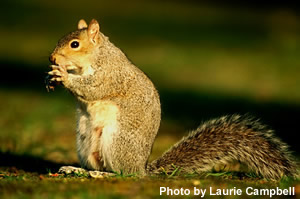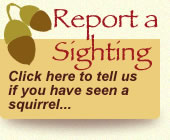Grey Squirrel Control
Grey Squirrel Control
If you have grey squirrels in your area and would like to help with grey squirrel control please contact us at RSSS via phone or email to join our Trap Loan Scheme.
Grey squirrels were introduced into Britain in the late 19th century (from 1876 onwards), and have replaced the native red squirrel in most of its former British range. It was initially thought that the greatest threat grey squirrels posed to red squirrels was as through competition for food and habitat resources, but more recently the role of the grey squirrel as a carrier of the deadly Squirrelpox virus has been recognised. When pox virus is present grey squirrels displace and replace red squirrels twenty times faster than in the absence of the virus. The Squirrelpox virus, rather than competition becomes the major cause of red squirrel mortality.
 Grey squirrel control has been part of the management protocol for red squirrel conservation in Scotland for many years but with the introduction of the Squirrelpox virus into Scotland the need to control grey squirrels has become more urgent. The aim of the present project is to create a pox free buffer zone in south Scotland to prevent the ‘virus carrying’ (seropositive) grey squirrels from England meeting up with the clean grey squirrels in the central belt. If these two grey squirrel fronts meet than the virus could quickly spread through the grey squirrels in the central belt and severely threaten the entire Scottish red squirrel population.
Grey squirrel control has been part of the management protocol for red squirrel conservation in Scotland for many years but with the introduction of the Squirrelpox virus into Scotland the need to control grey squirrels has become more urgent. The aim of the present project is to create a pox free buffer zone in south Scotland to prevent the ‘virus carrying’ (seropositive) grey squirrels from England meeting up with the clean grey squirrels in the central belt. If these two grey squirrel fronts meet than the virus could quickly spread through the grey squirrels in the central belt and severely threaten the entire Scottish red squirrel population.
Grey squirrel control in south Scotland is undertaken by both professional grey squirrel control officers (GSCO’s), volunteers and private landowners. Scottish Natural Heritage currently employs two full time GSCO’s who focus their control efforts along the main grey squirrel incursion routes into Scotland from northern England. The work of these officers has resulted in a significant decrease in grey squirrels and a welcome increase in the number of red squirrels seen in intensively controlled areas. The Forestry Commission (Scotland) have also recently hired four full time GSCO’s who are undertaking control on Forestry land throughout south Scotland as well as helping with control in other areas as required. The Scottish Wildlife Trust is funding two part-time seasonal GSCO’s to back up the coordinated efforts of these professionals.
Landowners and volunteers in south Scotland play a vital role in controlling grey squirrels and preventing the spread of the pox. Participants in the RSSS Trap Loan Scheme include many diverse people from large estate owners, to farmers to small householders in urban areas. Common in all of these people is a desire to help Scotland’s native red squirrels survive the grey invasion.
Click here for a printable version (pdf)

Please note this link will open a new window which will take you to the Scottish Wildlife Trust website where you can record your squirrel sightings.
Website by
Stewartry Technology





